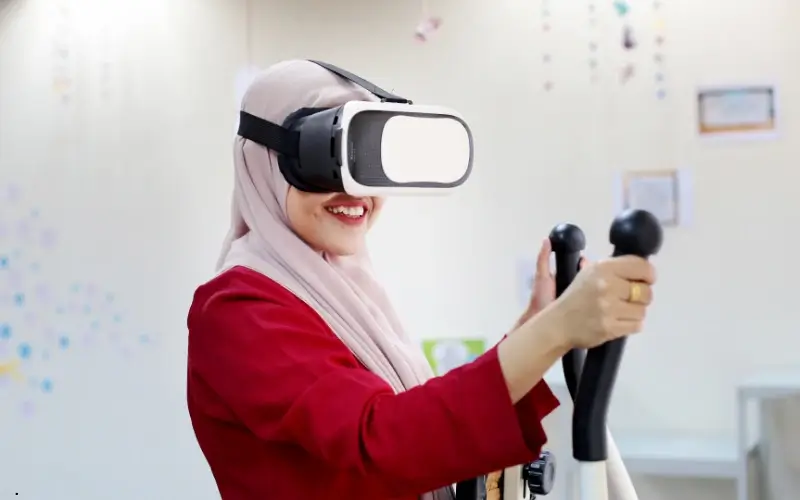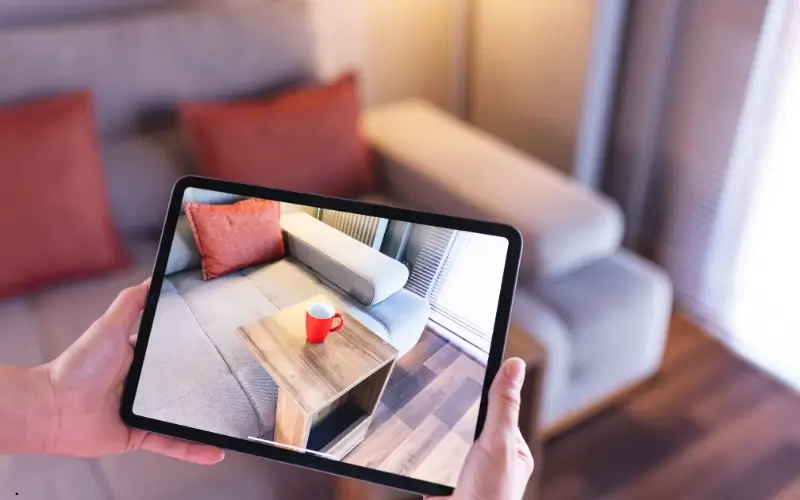XR Tips Every Event Organizer Needs to Know: From Industry Experts

.webp)
At a supermarket, a sales rep from The Hershey Company walked into an aisle with nothing more than an iPad. Within seconds, the empty shelves in front of her transformed into a digital planogram (a visual shelf layout showing how products should be arranged), perfectly stocked, perfectly lit, and rearranged at the tap of a finger. Store managers didn’t need to imagine what a new display might look like; they could see it right there in the space.
That moment, both ordinary and quietly revolutionary, captures how Extended Reality (XR) is already shaping experiences. Andy Hunt, Manager of Applied Digital Innovation at The Hershey Company, says it’s not about spectacle. “You cannot bring in all the merchandise and set it up,” Hunt explained. “But with AR on an iPad, a store manager can instantly see the full catalog, make changes, and sign off. It’s incredibly powerful in the field.”
Hunt’s team isn’t chasing headlines with headsets; they’re chasing efficiency. And that distinction matters. Flashy demos often dominate the XR conversation. But early adopters are proving that the real value comes when tools are aligned with actual problems worth solving, whether in retail or on a virtual event platform.
This article includes XR tips straight from industry experts, brand-new ideas you probably haven’t heard before, and ones you can actually use at your own events.
{{table-of-contents}}
XR for Events
%202.webp)
Events are no longer confined to stages or booths. They’re evolving into immersive event ecosystems, where physical presence meets digital possibility. Whether it’s a branded pop-up, a large expo, or a virtual job fair hosted on platforms like Frame or Remo, immersive tech is rewriting the rules of engagement. Extended Reality (XR) is not an abstract buzzword anymore: it is already shaping the way events are planned, marketed, and experienced.
But how exactly is XR being used today? And what can event organizers learn from the brands and experts experimenting at the frontier?
The State of XR & AI in Events Report 2025 by Events.com uncovered powerful signals:
- 67% of consumers say they would use augmented reality event experiences.
- 56% of brands already offer AR activations.
- Interacting with a product in AR can boost conversions by up to 94%.
These numbers are compelling, but it’s the voices of early adopters that bring the picture into focus. So, we spoke with leaders building the next era of events. Here’s what they shared, and what you can put into practice right now.
XR Is Already at Work

The perception that immersive technology is “too futuristic” is outdated. Many organizations are already applying XR in highly practical ways.
TIP #1: Use XR in targeted moments rather than across the entire event.
XR doesn’t need to dominate your event. Instead, think high-impact moments: a product launch, a complex demo, or recreating an environment you could never haul onsite.
TIP #2: Lean on VR when it allows attendees to experience something impossible in real life.
If something is too large, too dangerous, or too complex to showcase physically, VR is the right medium to bring it to life. Many VR event setups use this approach to simulate real-world experiences that can’t fit on a show floor.
Bonus Tip: Start where the friction is lowest. Mobile AR, accessed through QR codes or WebXR browsers, delivers immediate value—no hardware distribution is required.
Choosing the Right XR Medium for Your Event

If there’s one universal lesson from early adopters, it’s this: don’t treat XR like a monolith. Not every event needs VR headsets or smart glasses. The trick is picking the medium that matches the story.
TIP #3: Scope XR projects carefully to fit the hardware’s limits.
Don’t overpromise. Deliver right-sized activations that make reliable impact and won’t drain your resources.
TIP #4: Choose AR or WebXR for scale and simplicity.
Use mobile AR and WebXR because they are frictionless, device-agnostic, and drive higher adoption. If attendees can access an activation instantly with their own devices, adoption rates increase dramatically.
Curious about AR for events? From interactive product demos to location-based scavenger hunts, augmented reality brings participation to life, and it’s all covered in our in-depth article on how AR is used in events.
TIP #5: Never use VR for something that could just be streamed.
Well-designed VR for events activations focus on interaction, building, moving, and solving problems together, rather than passive viewing.
TIP #6: Use AR glasses as a backstage tool for staff and VIP coordination.
Glasses are emerging quietly in enterprise contexts. They can dramatically improve operations.
Bonus Tip: Match the technology to the moment. Use headsets sparingly for guided wow demos, AR for broad engagement, and glasses for staff or VIP scenarios.
Designing XR Experiences for Engagement and Participation

Early adopters agree: if XR proves anything, it’s that audiences want to do, not just see.
TIP #7: Design virtual spaces that match their capacity and purpose.
At one event, organizers built a sprawling VR campus to mirror a real-world convention center. But each VR instance capped at 40 users. Worse, most of the sessions were passive talks, attendees sat muted in headsets, watching slides.
The takeaway — Don’t overcrowd virtual spaces. Design for the scale of what platforms can handle.
TIP #8: Use XR and AI to solve real attendee pain points like networking.
The simplest way to implement XR and AI is to use them to solve a core attendee problem.
TIP #9: Build collective XR experiences that groups can enjoy together.
Design XR for shared, collective moments. That’s where immersion turns into something unforgettable.
Bonus Tip: If participants aren’t engaging within 10 seconds, you’ve already lost them. Every immersive moment should invite action—click, move, explore, solve.
Lowering Barriers to XR Adoption at Events

One of the biggest myths about immersive tech? That it’s too expensive. In reality, the real barriers are knowledge, onboarding, and execution.
TIP #10: Focus on reducing onboarding complexity rather than cutting costs.
Train staff thoroughly in XR before an event. Confident teams eliminate most adoption challenges.
TIP #11: Secure leadership buy-in early to avoid stalled adoption.
Without executive alignment, projects fail regardless of hardware or budgets.
Win leadership support early. Aligned executives unlock the resources, culture, and long-term commitment needed for XR projects to succeed.
TIP #12: Make every XR activation cross-platform.
Let audiences enjoy large-scale immersion, but keep it accessible across devices. Cross-platform design ensures everyone can join.
TIP #13: Prioritize accessibility and inclusivity when deploying XR.
Design with accessibility in mind because not only does it broaden reach but also builds trust, ensuring more attendees return for future events. Device-agnostic design ensures audiences feel welcomed instead of excluded.
TIP #14: Build transparency into every activation.
Communicate openly about data and algorithms. Transparency builds trust and paves the way for sustainable adoption.
Bonus Tip: Begin with a focused pilot, like a simple AR overlay, track engagement and results, then expand what works. Small wins build confidence and drive long-term adoption.
XR Lessons from Event Failures

Not every activation works. Failures teach as much as successes.
TIP #15: Test every platform against your audience’s profile before launch.
Don’t assume the shiniest tool will deliver the biggest impact. The best-designed AR filter fails if most of your attendees can’t access it.
TIP #16: Train staff in XR tools well before the event.
Train your team in XR tools well before attendees arrive. Confident staff create smooth adoption on the show floor.
The Future of XR in Events
Ask around, and one year keeps surfacing: 2026. Hunt believes that’s when lighter, cheaper, more consumer-friendly headsets will hit mass production, echoing the smartphone revolution.
Fidel agrees but emphasizes accessibility:
Gobindram adds a note of caution:
According to State of XR & AI in Events Report 2025, XR adoption in events is still fragmented, but the trajectory is clear. As hardware matures, mobile AR will remain the baseline, while headsets and glasses add new layers of depth.
Don’t wait for 2026. Begin with mobile/web XR pilots today, and start experimenting with AI copilots that handle matchmaking, scheduling, or data analysis. By the time hardware catches up, your team will already have the muscle memory.
That’s all what they shared, and here’s what you can put into practice right now. For brands looking to explore next-gen engagement, partnering with the best XR and AI event agencies can accelerate innovation and ensure flawless execution.
The Future of Events Is Layered
The future of events won’t be flat. It will be layered, with XR integrating digital possibilities into physical presence, turning every square foot and every second into an opportunity to engage. The message from early adopters is clear: you don’t need to overhaul your entire event. Start small, design for interaction, and let XR enhance the moments that matter most.
When attendees don’t just watch but participate, when they step into the story, navigate with ease, and see products come alive, the event doesn’t end when the lights go out. It lingers, it spreads, and it converts. One great XR activation beats a dozen gimmicks. Layer tech where it adds real value, and your events will resonate far beyond the room—especially when hosted on a platform like Remo, designed for immersive and interactive experiences. Book a demo today and see how Remo can bring your next event to life.
Frequently Asked Questions about XR Tips
1. What are practical XR tips for small or low-budget events?
Start simple: use mobile AR via QR codes or WebXR so attendees can access experiences on their own phones (no headsets required). Repurpose existing 3D assets (from product catalogs or CAD files) to save costs. Pilot XR in one high-impact moment (like a product demo or networking icebreaker) rather than the whole event.
2. How do I ensure XR experiences are inclusive & accessible?
Design device-agnostic activations that work on smartphones, tablets, and browsers, not just expensive headsets. Add captions, voiceover guidance, and alternative inputs for attendees with disabilities. Keep onboarding friction low — clear instructions, no mandatory app downloads, and support staff available to assist.
3. What metrics or KPIs should I track when I use XR activations?
Measure engagement (time spent in XR, number of interactions), conversion (leads generated, purchases, sign-ups), and satisfaction (post-event surveys, sentiment analysis).







.webp)



















